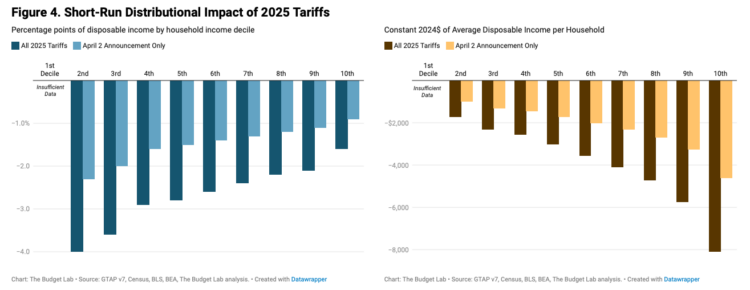By Gary Symons
TLL Editor in Chief
Stock markets are in free fall globally, while top brands grapple with the fallout of new US trade tariffs announced by President Donald Trump on April 2.
The tougher than expected tariffs are expected to impact on several sectors crucial to the global licensing industry, including the categories of toys, consumer electronics, fashion, automotive, food and beverage, and consumer goods in general.
In particular, toy prices could soar by roughly 50% as US consumers face a decline in their personal spending power of thousands of dollars.
What’s Behind America’s Tariff War
Billed by the president as ‘Liberation Day,’ the announcement levied 10% tariffs against the vast majority of other countries, but with much higher tariffs on countries deemed to have large trade surpluses with the U.S.
The Trump administration says the tariffs are designed to bring fairness to global trade, to bring manufacturing back to the United States, and to provide a new source of revenue for the federal government.
“For decades, our country has been looted, pillaged, raped and plundered by nations near and far, both friend and foe alike,” Trump said. “Jobs and factories will come roaring back into our country, and you see it happening already. We will supercharge our domestic industrial base. We will pry open foreign markets and break down foreign trade barriers, and ultimately, more production at home will mean stronger competition and lower prices for consumers.”
Markets Plummet As Economicsts Predict Inflation and Economic Slowdown
Trump’s view is questioned by economists, who predict the tariffs will lead to inflation, layoffs, and a strong likelihood of an imminent global recession that will also affect the U.S. retaliatory tariffs and trade measures from other countries are expected to deepen that impact.
Investors globally are betting against tariffs, with global markets being pummelled and stocks in top U.S. brands and companies falling sharply on the news.
That includes Apple, the world’s most valuable publicly listed company, which relies heavily on production in Asia for its computers, smart phones and tablets, and other consumer electronics goods.
Asian countries are a prime target for Trump’s tariffs, led by China, which was slapped with a 54% rate on imports to the US. The move prompted a rout on tech stocks, particularly when China quickly retaliated, with 34% tariffs on US goods.
Apple experienced a fall in market capitalization of more than $300 billion on Thursday in the worst single-day drop since 2020. Traders acted on fears the tariffs will dramatically increase its costs and fuel price increases for products such as its iPhone.
Apple makes most of its hardware in China, and two other leading production hubs, India and Vietnam, were also hit with 26% and 46% tariff rates.
Tariffs on Asian Nations to Hit Fashion Brands Hard

Also hit hard in trading were fashion brands like Nike, Levi’s, Gap and others. Like Apple, these countries are heavily dependent on Asian manufacturers in China, Bangladesh, Vietnam, Indonesia, and others.
Nike had responded to earlier trade measures by both the Trump and Biden administrations by moving some of its production out of China in a ‘friendshoring’ move to factories in Vietnam and Indonesia.
That move isn’t helping the company now, as those countries were also hit with massive tariffs. Roughly 95% of Nike’s products are produced in China, Vietnam and Indonesia.
Nike’s market value fell by $13 billion on Thursday, despite its efforts to reduce manufacturing in China in recent years. The high tariffs across many leading garment manufacturing countries also threatens significant supply chain cost increases of everything from tracksuits to sweaters.
GlobalData apparel analyst Alice Price said the tariffs will have “significant ramifications on the apparel market,” especially as major manufacturing hubs like China, Vietnam, and Bangladesh have been hit with rates as high as 54%.
“With the US having the largest apparel market globally, these tariffs will hugely impact global players like Abercrombie & Fitch and Nike, which have very diverse supply chains and import huge quantities into the country, while value players like Shein will see their low-cost propositions rocked,” Price said. “Players importing into the US will therefore have to find ways to offset these higher costs, and consumers may expect availability issues while they try to navigate these new challenges.
“It is most likely that brands will either push the additional costs onto US consumers, putting further strain on a region already grappling with inflationary challenges, or increase their prices globally to spread the impact more thinly.”
However, Price also said that attempts to onshore production in the U.S. will inevitably lead to higher prices in the long-term, due to the much higher wages paid in North America.
“While the tariffs have been imposed to encourage domestic production and self-reliance in the US, the logistics of moving manufacturing to the US will be challenging,” Price explained. “The US lacks the infrastructure and specialisation needed to produce apparel at competitive prices, and brands will still need to import materials from abroad, which will also be subject to tariffs, resulting in apparel prices still increasing.”
Toy Category Among the Hardest Hit by Tariffs

The same story is unfolding in the toy sector, a category of critical importance to the licensing industry.
Around 77% of toys imported into the United States come from China, according to The Toy Association. Most of the remaining market is dominated by Vietnam and Mexico. However, both those countries also face tariffs, particularly Vietnam. Trump previously placed a 25% tariff on goods from Mexico that aren’t compliant with the United States-Mexico-Canada Agreement.
Toy companies were hit hard in markets in the wake of the tariff announcement. Mattel shares fell more than 16.5% in Thursday trading, Hasbro lost more than 12% and Funko, which also has manufacturing in China and Vietnam, saw its stock plummet 18%.
“Everyone is really in scramble mode,” said The Toy Association CEO Greg Ahearn. “This is going to have massive negative repercussions for the consumer and for our industry.”
Ahearn says he expects a dramatic increase in toy prices in the U.S. due to the combination of tariffs and a retaliatory 34% levy by the Chinese government.
“You could have anywhere from 35% to potentially even a point-for-point price increase on products depending upon what margin those products run at,” Ahearn said. “It may actually just be a 50% price increase, given it’s a 54% tariff.”
Because profit margins on toys are typically in the high single digits, there is very little room for companies to absorb these fees.
“There’s no place for it to go, but to the consumer,” Ahearn said, adding that The Toy Association expects price hikes to coincide with this year’s back-to-school season. “The greatest budgetary impact are on the folks, unfortunately, who can afford it the least.”
That burden on consumers will include inflationary price increases on groceries and restaurants meals, as food prices are expected to increase for imported goods, particularly from Canada and Mexico. Brian Kelly, associate professor of economics at Seattle University, argues the tariffs have been imposed too broadly on too many countries and products, and are also too high.
“The numbers don’t work,” Kelly said. “They don’t make sense. They’re much too high.” He also says the first impact felt by consumers will be on imported fresh foods.
“Produce will be very quickly affected,” Kelly said. “Changes in cost of production for those products flow through the distribution channels very, very quickly simply because they’re perishable products.”
That will also include alcoholic beverages, with many of those brands being owned by American companies, and several being licensed products involving celebrities.
On the one hand, an imported tequila, like Dwayne ‘The Rock’ Johnson’s ‘Teremana’ brand, will face tariffs as the bottles cross the US border. On the other side of the line, US-produced products like Matthew McConaugey’s Wild Turkey Longbranch Bourbon will be hit with retaliatory tariffs when they are exported to Canada or Europe. As well, some jurisdictions have removed American liquor products from shelves, resulting in an immediate loss of sales.
American Buying Power to Decrease: Yale Budget Lab

The Yale Budget Lab has crunched the numbers and concluded that all of the tariffs to date will cause prices to rise by 2.3% in the short term, which is equivalent to an average per household consumer loss of $3,800 in 2024 dollars. Annual losses for households at the bottom of the income distribution are $1,700, but that number also reflects a higher percentage of low income earners’ overall budget. High income earners obviously will be affected more in dollar terms, with the top 10 per cent seeing their buying power decline by over $8,000, but they are also the least affected in terms of percentages.
Low income earners will see their buying power decline by 4%, while the highest income earners would only see a drop of just over 1.5%. For those reasons, luxury goods may see less of a hit than more mundane, everyday products.
